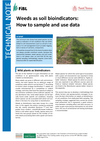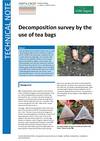FertilCrop Technical Notes
FertilCrop Technical Notes
Decomposition study using tea bags
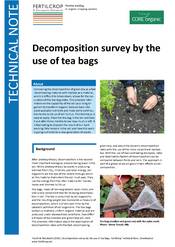
Comparing the decomposition of green tea as a fast-decomposing material with rooibos as a material, which is difficult to break down, allows for the calculation of the tea bag index. This provides information on the capability of the soil as a living organism to transform organic residues back into plant-available nutrients and make some contribution to the build-up of soil humus. This technique is easy to apply. Place the tea bag in the soil and take it out after three months to see how much is left. It is fascinating to discover the result of our hard working little helpers in the soil and how this work is giving nutrients to a new generation of plants.
The technical note "Decomposition study using tea bags" explains how this method can be applied. It was produced in the FertilCrop Project (Fertility Building Management Measures in Organic Cropping Systems).
Citation and download
Tresch, Simon and Fliessbach, Andreas (2016): Decomposition study using tea bags. Technical Note. Research Institute of Organic Agriculture (FiBL), Frick.
- orgprints.org: Decomposition study using tea bags
- orgprints.org: Evaluación de la descomposición con el uso de bolsas de té
- orgprints.org: Etude de la décomposition par l'utilisation de sachets de thé
- orgprints.org: Raziskava razgradnje s pomočjočajnih vrečk
Earthworm sampling
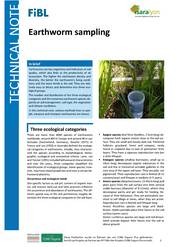
Earthworms are key organisms and indicators of soil quality, which also links to the productivity of an ecosystem. The higher the earthworm density and diversity, the better the earthworm’s living conditions and the more fertile is the soil. They are relatively easy to detect and determine into three ecological groups. The number and distribution of the three ecological categories and the numerous earthworm species de ‐ pends on soil management, soil type, the vegetation and climate conditions.
In this technical note, various methods how to sample, measure and interpret earthworms are shown. It was produced in the FertilCrop Project (Fertility Building Management Measures in Organic Cropping Systems).
Citation and download
Peigne, Joséphine, Huber, Kathrin and Pfiffner, Lukas (2018): Earthworm sampling. Technical Note. Research Institute of Organic Agriculture (FiBL), Frick, Switzerland and Ecole d’ingénieurs ISARA, Lyon Cedex, France.
- orgprints.org: Earthworm sampling
Examining root nodule activity on legumes
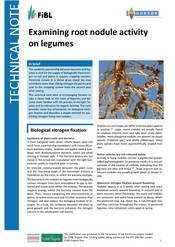
The symbiotic partnership between bacteria and legumes is vital for the supply of biologically fixed nitrogen to soil and plants in organic cropping systems. Perennial clovers in a dense grass clover ley may contribute more than 200 kg nitrogen (N) per ha and year to the cropping system from the second year after sowing.
This technical note aims at encouraging farmers to take a closer look at the roots of legumes and become more familiar with the process of nitrogen fixation and its relevance for organic farming. The note provides some key information on biological nitrogen fixation and describes a simple method for examining nitrogen-fixing root nodules.
Citation and download
Pommeresche, Reidun and Hansen, Sissel (2017): Examining root nodule activity on legumes. Technical Note. Research Institut of Organic Agriculture (FiBL), CH-Frick and Norwegian Centre for Organic Agriculture (NORSØK), Tingvoll.
- orgprints.org: Examining root nodule activity on legumes
- orgprints.org: Examen de la actividad de los nódulos en raíces de leguminosas
- orgprints.org: Sjekk belgvekstenes egen nitrogenproduksjon
Weeds as soil bioindicators: How to sample and use data
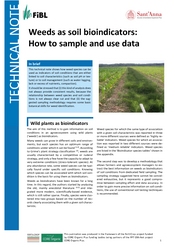
This technical note shows how weed species can be used as indicators of soil conditions that are either linked to soil characteristics (such as soil pH or texture) or to soil management (such as water logging, lack or excess of nutrients, compaction). It also includes a table on how to interprets the findings and a boindicator species table.
It should be stressed that (i) this kind of analysis does not always provide consistent results, because the relationship between weed species and soil conditionsis not always clear cut and that (ii) the suggested sampling methodology requires some basic botanical skills for weed identification.
Citation and download
Carlesi, Stefano and Barberi, Paolo (2017): Weeds as soil bioindicators: How to sample and use data. Technical Note. Research Institute of Organic Agriculture (FiBL), Frick and Scuola Superiore Sant’Anna (SSSA), Pisa.
 This website was archived on January 11, 2020 and is no longer updated.
This website was archived on January 11, 2020 and is no longer updated.
